New Caledonia is a special collectivity of France inthe southwest Pacific Ocean, south of Vanuatu, about 1,210 km (750 mi) east of Australia and 17,000 km (11,000 mi) from Metropolitan France. The archipelago, part of the Melanesia subregion, includes the main island of Grande Terre, the Loyalty Islands, the Chesterfield Islands, the Belep archipelago, the Isle of Pines, and a few remote islets. The Chesterfield Islands are in the Coral Sea. French people, especially locals, call Grande Terre Le Caillou (“the pebble”).
New Caledonia has a land area of 18,576 km2 (7,172 sq mi) divided into three provinces. The North and South Provinces are on the New Caledonian mainland, while the Loyalty Islands Province is a series of islands off the mainland. Its population of 271,407 (October 2019 census) consists of a mix of the original inhabitants, Kanaks, who are the majority in the North Province and in the Loyalty Islands Province, and people of European descent (Caldoches and Metropolitan French), Polynesians (mostly Wallisians), and Southeast Asians, as well as a few people of Pied-Noir and North African descent, who are the majority in the rich South Province. The capital of the territory is Nouméa.
|
New Caledonia |
|
|
|
|
|
|
|
| Sovereign state | France |
| Annexed by France | 1853 |
| Overseas territory | 1946 |
| Nouméa Accord | 5 May 1998 |
| Capital
and largest city |
Nouméa 22°16′S 166°28′E |
| Official languages | French |
| Recognised regional languages |
|
| Demonym(s) | New Caledonian |
|
Area |
|
| • Total | 18,576 km2 (7,172 sq mi) |
| • Land | 18,275 km2 (7,056 sq mi) |
| • Water (%) | 1.6 |
| Highest elevation | 1,629 m (5,344 ft) |
|
Population |
|
| • 2019 census | 271,407[2] (184th) |
| • Density | 14.5/km2 (37.6/sq mi) (200th) |
| Currency | CFP franc (XPF) |
| Time zone | UTC+11:00 |
CULTURE
KANAK CULTURE
The Kanak people are the native people of New Caledonia. They are the largest ethnic group in New Caledonia and have inhabited the archipelago for about 6,000 years, living in autonomous tribal communities in the narrow valleys between the mountains.
New Caledonia counts 341 tribes which perpetuate this ancestral way of life, living mainly off agriculture and fishing. Kanak culture is based on oral transmission, exchange, myths and animist legends, the traditions being the central axis of the culture that governs its social organization. This culture regroups its people in a traditional society founded on an organisation determined by the clans, with clearly defined relationships in terms of hierarchy. Men and women comply with established roles. Besides, the wisdom of their ancestors is always pre-eminent and their attachment to the land is strong.
Wood carving, especially of the houp (Montrouziera cauliflora), is a contemporary reflection of the beliefs of the traditional tribal society, and includes totems, masks, chambranles, or flèche faîtière, a kind of arrow that adorns the roofs of Kanak houses. Basketry is a craft widely practiced by tribal women, creating objects of daily use.
The Jean-Marie Tjibaou Cultural Centre, designed by Italian architect Renzo Piano and opened in 1998, is the icon of the Kanak culture.
The Kaneka is a form of local music, inspired by reggae and originating in the 1980s.
The Mwâ Ka is a 12m totem pole commemorating the French annexation of New Caledonia, and was inaugurated in 2005
TEXTILE OF NEW CALEDONIA
TAPA CLOTH
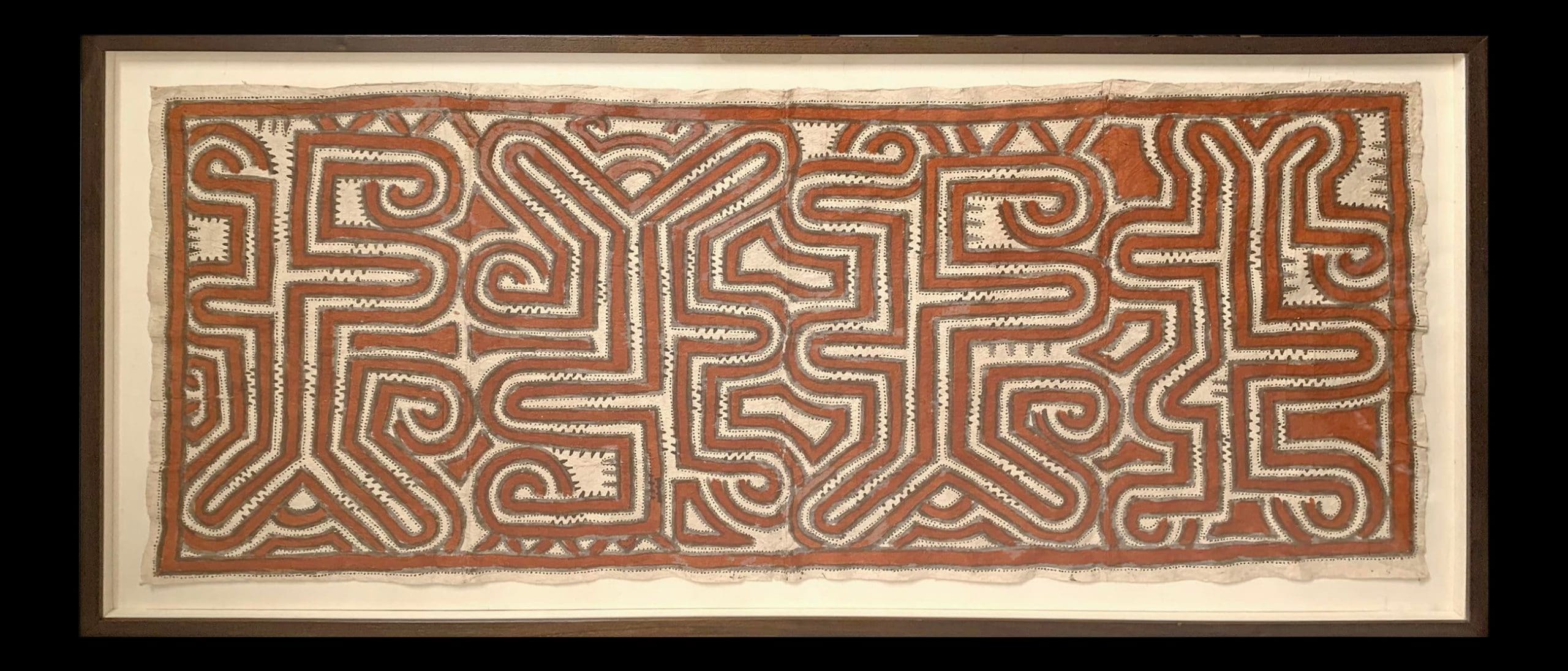
Tapa is the name given to the delicate, intricately decorated cloth made from the bark of the paper mulberry tree. Tapa is traditionally made by women; strips of beaten bark are sown together to make cloths of different sizes, which are then decorated with hand-painted geometric designs. Tapa is a key art form in Wallis and Futuna but is also found throughout Oceania. Tapa cloth can be used to make everyday objects: wallets, card cases, pouches and handbags…
MANOU
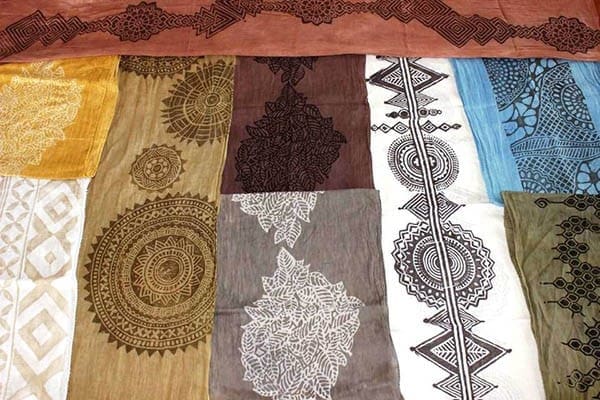
A “manou” is far more than a piece of brightly coloured cloth, it plays a central role in Kanak customary ritual. Accompanied by tobacco and a small amount of money, a manou is given as a customary gift. In some customary areas, it has been replaced by a woven pandanus mat. This “customary gesture”, which precedes any spoken exchange, is a mark of consideration and respect between host and guest. It is an ancient customary ritual reflecting Melanesian cultural tradition. Today, manous have also taken on a new life as attractive sarongs hand-dyed or decorated with painted designs by local artisans. They make delightful souvenirs!
WOVEN ARTWORKS
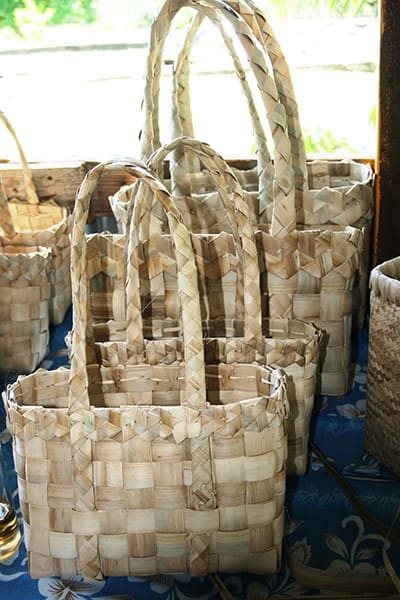
Pandanus and coconut palm leaves, rushes and a variety of plants can be woven to create practical or decorative articles: bags, cases or sheaths, hats, fans, hanging mobiles, paniers, baskets… Traditional weaving skills are passed down by women from one generation to the next. Woven pandanus mats are used in customary ceremonies, with the woven strands symbolising the bonds woven between people. You will find mats in various sizes, each designed for a specific occasion.
JEWELRY OF NEW CALEDONIA
Engraved mother-of-pearl, shells and Megalodon teeth
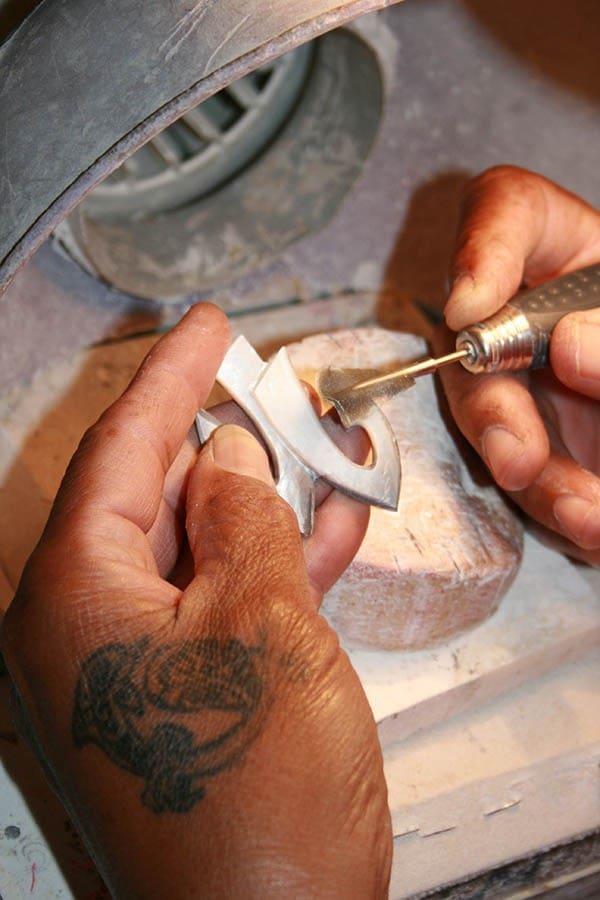
Carcharocles megalodon, an impressive ancestor of the great white shark, was around 18 metres long! The fossilised teeth of this ancient giant of the seas can measure up to 20 cm long. A deposit of several thousand teeth was discovered at a depth of 500 metres off the coast of New Caledonia. Such giant teeth make unusual and intriguing artworks, polished, engraved, made into a pendant or framed. Engravings on mother-of-pearl are an art form going back to the 19th century and the days of the penal colony, when convicts engraved shells in secret to be smuggled to local buyers as a stealthy way of making a little money.
CLOTHING OF NEW CALEDONIAN
Mother Hubbard dresses

Mother Hubbard dresses are long and loose; they have modest round necks and are usually brightly coloured. They were introduced by 19th Christian missionaries who judged female native garb to be unseemly. Today, Mother Hubbard dresses are worn proudly as a symbol of Melanesian femininity. Originally, only Kanak women wore the garment, but other women followed suit and the basic design has grown more innovative. The same applies to Tahitian dresses, which are now seen as an emblem of traditional craft skills and Oceanian creativity
LAPITA POTTERY

The ancient Lapita potteries date to 1500 BC. Essentially a women’s craft, the pottery is generally decorated with geometric patterns and stylised human faces, although there is variation between northern and southern New Caledonian pottery. The various handles and glazes have pinhole-incised designs made from tooth combs. The pottery was made from clay deposits found in the islands.
WOOD SCULPTURES

Wood sculpture represents the spirit of Kanak culture of which the Flèche faîtière, which resembles a small totem pole with symbolic shapes, is the most common. A mini Stonehenge-looking religious memorial near the village in L’Île-des-Pins has a display of religious carvings. Other wooden objects include war clubs carved from the strongest wood, made in the form of a phallic head (casse-tete), a lethal bird’s beak club (bec d’oiseau), and spears made from niaouli trees used to burn enemy houses.
Wooden carvings in the shape of hawks, ancient gods, serpents and turtles are also popular. The Grand Huts, also known as grande case (chef’s hut), are decorated with the filial of fleche faitiere representing the ancestral spirits, symbolic of transition between the world of the dead and the world of the living. The wood carving is shaped like the spear-like carving that adorns the top of the grande case. It comprises three parts; the flat crowned face representing the ancestor with a long, the rounded pole run through by conch shells mounted on it that represents the ancestor’s voice, and a base with the pole fixed to it to symbolise the link between the clan and the chief. The central piece is also flanked by wooden pieces with sharp points (facing downwards) that are intended to prevent bad spirits enveloping the ancestor in the central part. As it represented the power of the chiefs over their subjects, it was adopted as flag of the Kanaks by the organization leading the independent movement in New Caledonia. The arrow or the spear normally has a needle at the end to insert threaded shells from bottom to top. After the death of a Kanak chief, the fleche faitière is removed and his family takes it to their home. Though it was allowed to be used again as a sign of respect it is normally kept at burial grounds of noted citizens or at the mounds of abandoned grand houses
STONE CARVINGS
Stone carvings made of jade or serpentinite are in the form of ceremonial axe representing clan’s strength and power. These were used to behead enemies during war and during ancestor celebrations known as Pilou. The bottom of the handle represents the particular clan and is embellished with stones and shells. The axe is polished smooth like a disc. Carvings made of soapstone are also popular.
WOOD CARVINGS

A meter in length canes, dated between 1850 and 1920, are used to make an entry into a village or in dance ceremonies. The canes were fired to give black patina over the engraved parts; the engraving designs consist of geometrical real images from the pilou dance, agricultural motifs and village scenes of fishing or building a Grand Hut or case. These were also stuffed with magic herbs to ward off evil spirits.
REFRENCES
https://en.wikipedia.org/wiki/New_Caledonia#Culture
https://en.wikipedia.org/wiki/Kanak_people
https://www.ardici.nc/en/buy-what-and-where
By- Janvi Nagada (MSc. in Textile and Fashion Technology)


 FLAG
FLAG UNOFFICIAL FLNKS FLAG
UNOFFICIAL FLNKS FLAG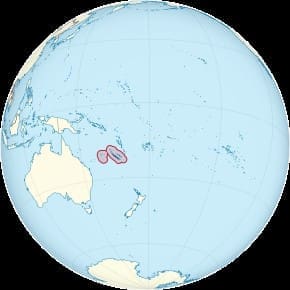 Location of New Caledonia
Location of New Caledonia